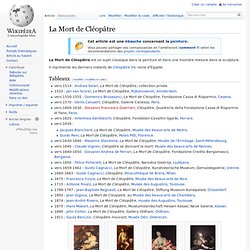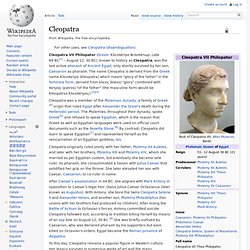

La Mort de Cléopâtre. Un article de Wikipédia, l'encyclopédie libre.

La Mort de Cléopâtre est un sujet classique dans la peinture et dans une moindre mesure dans la sculpture. Il représente les derniers instants de Cléopâtre VII, reine d'Égypte. Cultural depictions of Cleopatra VII. Category:Cleopatra and Iulius Caesar. Category:Antony and Cleopatra. Category:Death of Cleopatra. Category:Cleopatra in sculpture. Category:Cleopatra in paintings. Category:Portraits as Cleopatra. Cleopatra VII. Cleopatra VII Philopator (Greek: Κλεοπάτρα Φιλοπάτωρ; Late 69 BC[1] – August 12, 30 BC), known to history as Cleopatra, was the last active pharaoh of Ancient Egypt, only shortly survived by her son, Caesarion as pharaoh.

The name Cleopatra is derived from the Greek name Κλεοπατρα (Kleopatra) which meant "glory of the father" in the feminine form, derived from κλεος (kleos) "glory" combined with πατρος (patros) "of the father" (the masculine form would be Kleopatros Κλεοπατρος).[2][3] Cleopatra was a member of the Ptolemaic dynasty, a family of Greek [4] origin that ruled Egypt after Alexander the Great's death during the Hellenistic period. The Ptolemies, throughout their dynasty, spoke Greek[5] and refused to speak Egyptian, which is the reason that Greek as well as Egyptian languages were used on official court documents such as the Rosetta Stone.[6] By contrast, Cleopatra did learn to speak Egyptian[7] and represented herself as the reincarnation of an Egyptian goddess, Isis.